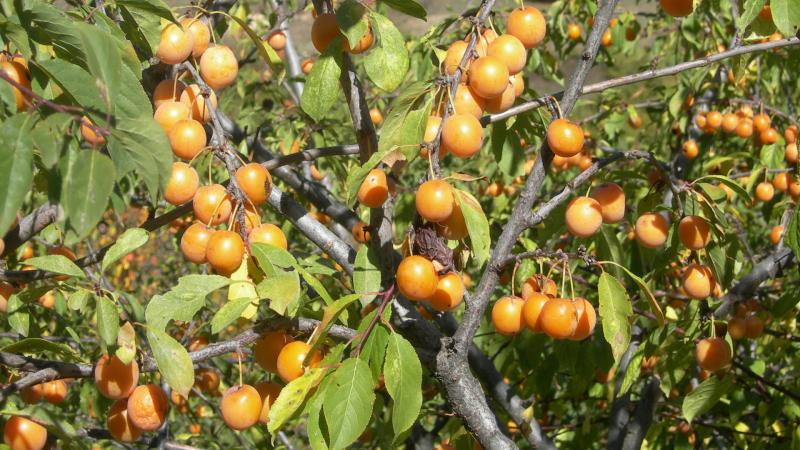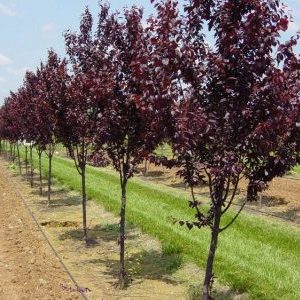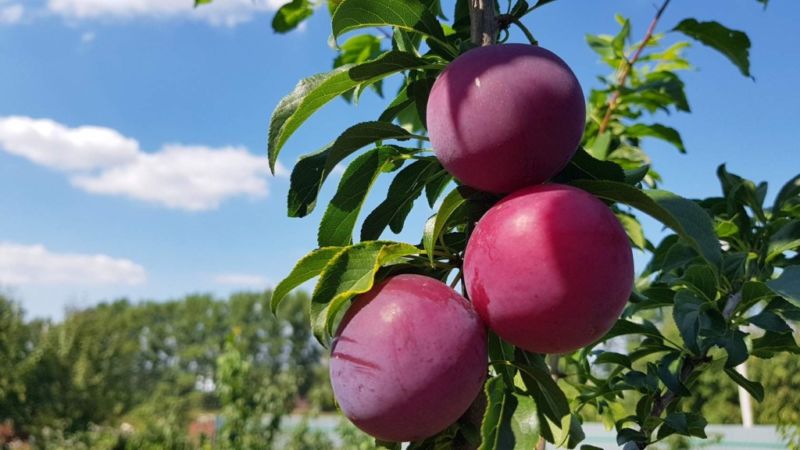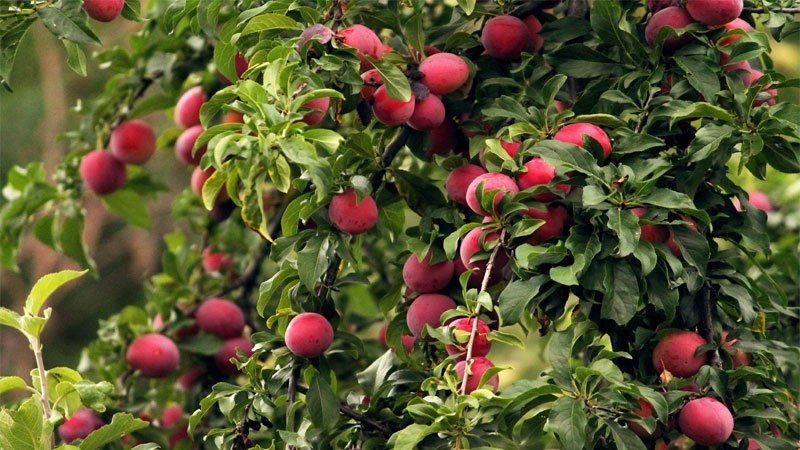Step-by-step instructions for planting cherry plum in the fall
Cherry plum is a relative of the plum. Its fruits have a pleasant sweet and sour taste and a pronounced plum aroma. It is suitable for preparing desserts and sauces for meat.
Cherry plum is a thermophilic plant. Previously, it was grown only in warm regions, but thanks to the efforts of breeders, varieties were bred that could withstand severe winters and grow in the central regions of Russia. A tree is planted in autumn or spring, depending on the region. Read more about planting cherry plum in the fall.
The content of the article
Cherry plum varieties suitable for autumn planting
Earlier, it was impossible to grow thermophilic cherry plum in the Leningrad, Moscow regions, and even more so in Siberia. But thanks to breeding, cold-resistant varieties that can grow in cold climates have appeared on the market.

In order for the tree to take root on the site, it is important to choose a variety that is suitable for a specific region.
The list contains the most popular varieties of cherry plum:
- Gold of the Scythians. An early variety that bears fruit in June. It has yellow sweet and sour fruits weighing up to 40 g. Differs in resistance to winter cold snaps. The bone is poorly separated from the pulp.
- Found. Mid-season variety, bearing fruit in July. Frost-resistant, demanding on humidity. Gives sweet and sour yellow fruits, the weight of which reaches 35 g. The stone does not separate.
- Traveler. Mid-season. It has yellow fruits weighing up to 30 g with a banana flavor.
- Ruby. Mid-season, frost-resistant variety. Produces sweet fruits with dark red skin and orange flesh.
- Timiryazevskaya. An early variety with high frost resistance and good immunity. The fruits have a burgundy skin and yellow flesh. The bone is easily separated. The weight of one fruit reaches 25 g.
- Tent. Cold and drought-resistant tree. It has yellow fruits on the inside and outside, weighing up to 35 g. The stone is easily separated from the pulp.
- Yarilo. Cold-resistant variety. Has red inside and outside fruits weighing up to 40 g with a rich taste and aroma.
- Sigma. A frost-resistant tree that produces yellow fruits weighing up to 35 g.
- Cuban comet. Mid-season variety resistant to frost and drought. The weight of each yellow-sweet fruit reaches 30 g. Of the presented, the only self-fertile variety.
- Cleopatra. Frost-resistant and drought-resistant variety. Produces sweet fruits with dark purple skin and red flesh. Each weighs 40-50 g.
- Granite. Late variety of cherry plum. Winter and drought tolerant. Produces yellow fruits with a waxy coating.
Almost all of the varieties presented are self-fertile. This means that for their fruiting, one more cherry plum tree is needed on the site.
Note! Self-fertile trees are able to bear fruit without another cherry plum on the site, but the yield in this case will be lower.
Selection and preparation of seedlings
 When choosing a cherry plum seedling, it is important to pay attention to its varietal characteristics. A plant that will grow in the middle lane (in St. Petersburg) or in the Middle Urals must have a high frost resistance. Drought-resistant varieties and hybrids are suitable for the southern regions.
When choosing a cherry plum seedling, it is important to pay attention to its varietal characteristics. A plant that will grow in the middle lane (in St. Petersburg) or in the Middle Urals must have a high frost resistance. Drought-resistant varieties and hybrids are suitable for the southern regions.
Young saplings - not older than a year have the best survival rate. They must have a closed root system or be in water.
It is important to pay attention to the root system. It should be formed, the roots on the cut are white. Small roots will die off during transplantation.
The seedling must be dormant.This is evidenced by unopened and non-swollen kidneys.
The seedlings are transferred in a bucket of water. It is advisable to deliver it to the garden as soon as possible and plant it. If this is not possible, the plant is buried in the shade at an angle.
Place for cherry plum
In order for the seedling to take root and give good yields in the future, it is important to choose the right place for it. Otherwise, the plant will die.
Cherry plum is a moisture-loving plant. It grows well in areas with a close location of groundwater.
It is important that the chosen location is well lit by the sun. Cherry plum does not like shade, with a lack of sunlight, it gets sick and does not tie fruit well.
For planting cherry plum, choose a southern or southeastern slope. It is desirable that it be closed from the winds from all directions.
Landing dates
When is the best time to plant cherry plum depends on the region... Autumn planting is optimal for regions with a warm climate. In this case, the plant is planted in the second half of October.
In the Moscow region and other regions with a temperate climate, planting is also possible in the autumn. The plant is planted in September so that it has time to take root before the onset of frost.
In the north of our country, seedlings are able to take root only in spring. With an autumn planting, they will not have time to do this before frost and will die.
Rules for autumn planting cherry plum
How quickly the plant takes root and whether it can overwinter depends on how correctly the planting is performed. Special attention is paid to this stage of cherry plum growing.
Required materials and tools
To plant cherry plum, you will need a number of tools and materials:
- Shovel and rake for planting and hilling seedlings.
- Litmus paper to make an acidity test. Chalk, lime or gypsum depending on the acidity level of the soil.
- Fertilizers. Usually use "Nitrofoska", humus or rotted manure.
- Seedling root treatment agent - growth stimulator with clay.
- Mulch: sawdust, humus, rotted straw.
Step-by-step instruction
Planting a seedling is not difficult. The main thing is to follow the recommendations exactly:
- The hole is prepared two weeks before planting the cherry plum. A hole is dug 60 cm deep and 100 cm in diameter. Two-thirds of it is filled with earth, 1 kg of "Nitrofoski" and 20 kg of humus are poured on top.

- Check the acidity of the soil. If the indicators are increased, add dry lime; if lowered - gypsum. Sand is added to heavy soil, turf is added to sandy soil.
- Before planting, the roots of the seedling are immersed in a clay mash (1 kg of clay is added to 5 liters of water) with a growth stimulator, for example, "Heteroauxin" (it is added according to the instructions).
- The seedling is placed in a hole on an earthen mound, the roots are straightened. Sprinkle it on top with soil mixture so that the root collar remains open. The soil around the tree is compacted.
- The upper part of the seedling is cut at a height of 30 cm.
- The seedling is watered with 5-10 liters of water. Pour a layer of mulch on top.
To help the seedling take root, it is recommended to tie it to a peg.
Council. To get rich harvests, it is recommended to plant two cherry plum trees at a distance of 2-4 m.
Further care of seedlings
It is not difficult to grow cherry plum. She is unpretentious, and she is rarely affected by diseases. However, it is important for the plant to be properly cared for. It differs in autumn, summer, spring and winter.
In winter
In winter, trees are dormant, so they do not require special care. To protect the plant from the cold, it is recommended to make a small mound of snow around its trunk.
In the spring
Spring care for cherry plum includes a number of mandatory activities. These include:
- Getting rid of excess moisture. If a lot of snow has fallen in winter, grooves are dug near the cherry plum to drain moisture.
- Treatment... The branches of young seedlings in the first 2-3 years of life are treated with a 3% solution of copper sulfate without prior preparation. Dead bark is preliminarily removed from adult plants.
- Digging the soil around the tree. The procedure is carried out in April.This is necessary for a better supply of water and nutrients, as well as the normalization of air exchange in the roots.
- Watering... If there was no snow in winter and rain in spring, in the spring the tree is watered once.
- Removal of overgrowth. It is either cut down, or dug up and separated from the mother's root to obtain a healthy seedling. Shoots appear no earlier than three years after planting.
- Pruning... Gradually the plant is formed into a tree or bush. The second option is suitable for regions with cool climates. In this case, the branches are cut at a height of 30 cm from the ground, leaving 5-6 branches, which are shortened at a height of 50 cm and maximally diverted to horizontal positions using stretch marks. If the cherry plum is formed into a tree, the crown is cut in the form of a bowl, leaving 5-7 main branches. In the first year, only three branches are left from the trunk at a distance of 15-20 cm from each other and extending from the trunk at an angle of 45-60 degrees. Over the next two years, more branches are added according to the same rules. After three years, the crown will be formed, and the top of the guide is cut at the level of the third skeletal branch. Mature plants only need sanitary pruning, during which all dry branches that create unnecessary shade are removed. Places of cuts must be treated with garden pitch.
- Top dressing. In the spring, nitrogen-containing fertilizers are applied. For 1 sq. m instill 90 g of ammonium nitrate before flowering. During the formation of ovaries in early varieties, 60 g of urea per 1 sq. m.
- Spraying buds. For this, a solution of trace elements is used.
It is interesting:
How grapes should be planted in autumn.
A step-by-step guide for transplanting and caring for Batun onions in the fall.
Summer
In summer, other events are held:
- Watering. If the summer is dry, the cherry plum is watered at least three times during the entire period. Pour 10 liters of settled water at room temperature under each tree.
- Loosening. After each watering, the soil around the tree is loosened to a depth of 8 to 12 cm.
- Weeding. In the process of loosening, weeds are removed. This is especially important to do while the plant is young.
- Mulching. It is recommended to mulch the soil around the tree. For this, peat, sawdust, rotted hay or straw are used. Mulch slows down the growth of weeds and eliminates the need for loosening.
- Pruning shoots... If new growth appears in the summer, it is cut out.
- Foliar dressing... Four weeks after the first feeding, the tree is sprayed again with preparations containing potassium, phosphorus and trace elements.
- Organic feeding. It is brought in in August. For 20 liters of water, take 1 liter of chicken manure. Mullein is also used in a ratio of 1: 8.
In autumn

In the fall, cherry plum is prepared for wintering. This is done as follows:
- The soil around the cherry plum is dug up and cleaned of weeds. In the process, organic fertilizers and superphosphate are applied. 6 kg of rotted manure and 30 g of superphosphate are laid under one cherry plum.
- The soil is moistened when the leaves begin to turn yellow. It is important that the water saturates the soil to a depth of 0.4-0.6 m.
- Dead bark particles are removed from trees at the end of October. Shoots are cut out.
- The trunk and base of the branches are covered with lime.
- Fallen leaves and other plant debris are removed from the site.
Diseases and pests
Cherry plum is rarely exposed to disease. However, some infections do affect it. Proper care will help to avoid plant contamination.
Cherry plum diseases:
- Hole spotting. Brown spots with a dark rim appear on the leaves, later the infection spreads to the branches and fruits. This leads to deformation of the fruit and a deterioration in their taste, gum begins to flow from the affected areas on the branches. The prevention of the disease is the timely removal of fallen leaves, sanitary pruning of dry branches, spring treatment with copper sulfate.For treatment at the stage of staining the buds, the plant is sprayed with 1% Bordeaux liquid, the second treatment is carried out two weeks later, the last one - 20 days before harvest.
- Milky shine. The leaves are covered with a white bloom, the leaves become brown, the affected branches of the plant begin to dry out. This is a fungal disease, for the prevention of which spring and autumn treatment with copper sulfate is carried out and the stem is painted with lime. To cure the cherry plum, the affected branches are cut off. The cut sites are treated with 1% copper sulfate and covered with garden varnish.
- False milky shine... The leaves are covered with a white bloom, the plant sets few fruits. Occurs when cherry plum freezes in winter. Frequent feeding and watering of the tree will help to correct the situation.
- Moniliosis. Gray bumps appear on the leaves, in which there are fungal spores. The branches turn brown, dry up and rot, and growths appear on them. Fruits are also covered with gray and brown spots and become unsuitable for eating. All affected specimens are plucked and burned. The affected parts of the plant are also removed. The cut sites are treated with copper sulfate and garden varnish.
- Marsupial disease. The fruits become twisted, shriveled, tasteless, do not ripen, and seeds do not form in them. The stems swell and bend. During treatment, all infected fruits and other parts of the plant are removed. The tree is treated with Bordeaux liquid, which is also used for prophylaxis.
- Coccomycosis. The leaves are covered with red-brown spots on top and a whitish bloom below, quickly turn yellow and fly around. The fruits do not ripen and fall off. All affected foliage and fruits are harvested and burned. The tree is treated with 1% Bordeaux mixture or HOM preparation.
Cherry plum is very fond of pests. These include:
- Brown fruit mite... The leaves turn brown and die off, the fruits are not formed. Prevention is the removal of dead bark, treatment - treatment with "Fufanon".
- The slimy sawfly eats the leaf plates. Prevention consists in the timely removal of foliage and plant sediments from the site, treatment - in processing the plant in August with "Fufanon".
- Yellow plum sawfly. The larvae devour bones, pulp and young shoots. Adult insects are harvested by hand or shaken off the tree onto a film, and then burned. To avoid repeated damage, the tree is sprayed with "Fufanon" at the beginning and at the end of flowering.
- Eastern moth. Devours young shoots, leading to their death, and the pulp of fruits. For treatment and prevention, the tree is sprayed after flowering and harvesting the fruits with a saline solution prepared from 0.5 kg of salt and 10 liters of water. A young seedling takes 2 liters of solution, and an adult tree - 7 liters.
- Plum moth... The caterpillar lives in fruits, devouring them and filling them with waste products. For prevention, remove fallen leaves, fruits and unnecessary vegetation. For treatment, the tree is treated with "Fufanon".
- Plum aphid... It feeds on the sap of leaves and shoots, leading to their yellowing and death. To combat the pest, the plant is treated with "Karbofos".
- Subcortical leafworm. Gnaws through passages in wood, leading to the death of individual branches or the entire plant. The affected parts of the tree are removed, the cut sites are treated with garden pitch.
Is it possible to transplant cherry plum in the fall to a new place

Is it possible to transplant cherry plum to a new place? This question is asked by gardeners who initially chose the wrong place for planting. Answer: yes, you can, but subject to a number of rules and conditions.
Before replanting a plant, you need to determine its age. Best of all, trees not older than five years take root in a new place. An older cherry plum forms lateral roots more slowly, which means it takes root worse.
Transplanting cherry plums over five years to a new place is possible only if there is a closed root system. But even in this case, there is no guarantee that the tree will take root.
Step-by-step instructions for transplanting cherry plum to a new location:
- Immediately before transplanting, the tree is watered with 3-5 buckets of water. This will make it easier to retrieve it from the ground.
- When the water is absorbed, the tree is dug in along the diameter of the crown to a depth of 70 cm. Alychu is carefully removed from the soil along with a lump of earth, trying not to damage even small root processes.
- The roots with an earthen lump are covered with a film or cloth. It is recommended to transfer the tree to a new place on plywood so that the earthen lump does not disintegrate.
- In a new place, the cherry plum is placed in the hole so that the root collar is located at the level of the soil surface.
- The hole is covered with a mixture of garden soil, humus and "Nitrofoski". The soil around the trunk is carefully compacted.
- A layer of mulch (sawdust, peat, rotted straw) is poured around the tree. Cherry plum is tied to a support and watered abundantly.
An autumn transplant of cherry plum is done a month before the onset of frost.
Read also:
Manure as a fertilizer for potatoes: when is it better to apply, in autumn or spring.
Conclusion
Planting a cherry plum seedling is an easy, but responsible task. It is on how correctly the place for the tree is chosen and prepared that its endurance and yield depend.
Taking care of the cherry plum is also easy. The main thing is to apply top dressing in a timely manner, carry out pruning and prevent the development of diseases and pests.